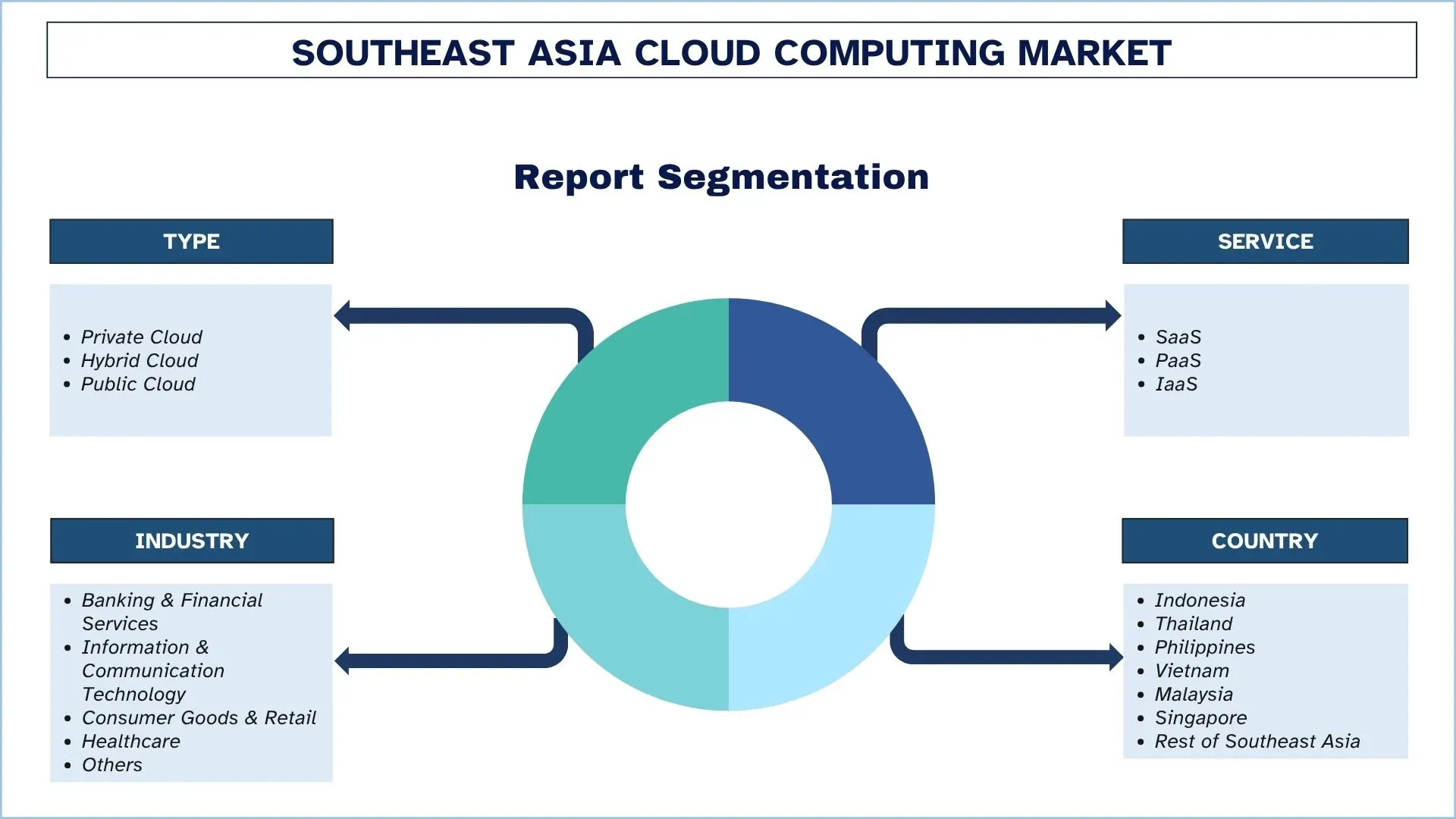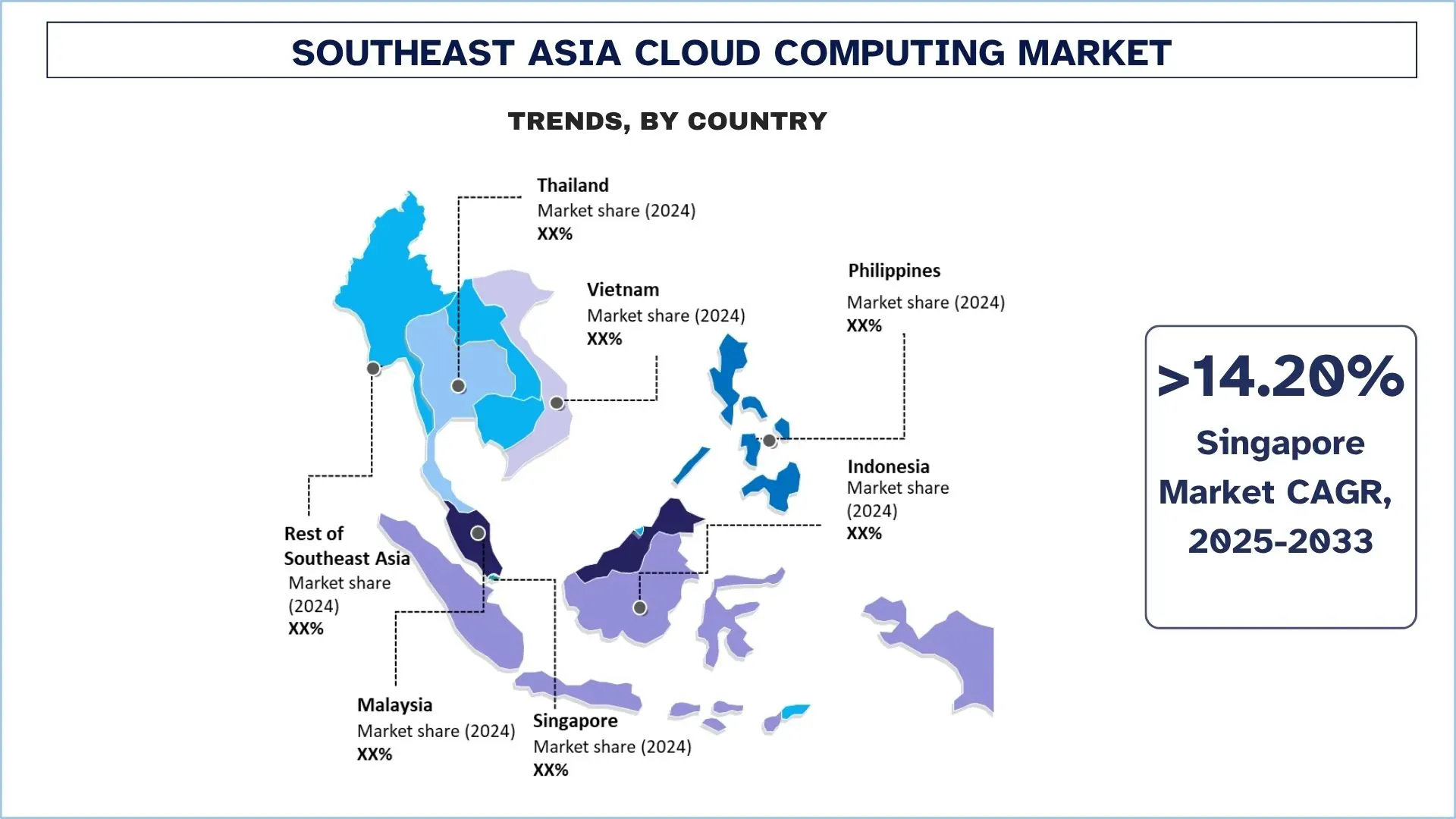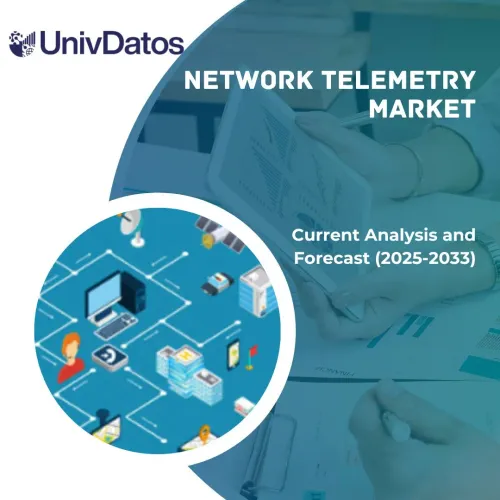- Home
- About Us
- Industry
- Services
- Reading
- Contact Us
Southeast Asia Cloud Computing Market: Current Analysis and Forecast (2025-2033)
Emphasis on Type (Private Cloud, Hybrid Cloud, Public Cloud); Service (SaaS, PaaS, IaaS); Industry (Banking & Financial Services, Information & Communication Technology, Government, Consumer Goods & Retail, Healthcare, and Others); and Country.

Southeast Asia Cloud Computing Market Size & Forecast
The Southeast Asia Cloud Computing Market was valued at ~USD 30,517.83 million in 2024 and is expected to grow at a strong CAGR of approximately 14.56% during the forecast period (2025-2033F), driven by an increasing focus on decarbonization and the transition to renewable energy sources.
Southeast Asia Cloud Computing Market Analysis
Cloud computing refers to the provision of computing services, such as servers, storage, databases, networking, software, and analytics via the internet. It enables organizations to have access to resources on demand without having to invest in physical infrastructure. The model is flexible, scalable, and economical to both small and large businesses.
Southeast Asian companies are adopting a combination of public, private, and hybrid cloud architectures to transform digitally. Adding to this, adoption of the cloud involves SaaS applications, IaaS applications for scaling infrastructure, and PaaS applications for developing and deploying an application. To enhance business efficiency and facilitate innovation, companies are increasingly incorporating cloud and AI, analytics, IoT, and data management solutions. Also, the migration of legacy systems, disaster recovery configurations, and multi-cloud strategies aims to create a more resilient and agile position in a competitive environment, which is part of this adoption process.
On March 12, 2025, Oracle and Microsoft offered Oracle Database@Azure to customers in Southeast Asia. With the services’ debut in the Microsoft Azure Southeast Asia region, customers gain all the performance, resiliency, security, scale, and workload availability advantages of Oracle Database on Oracle Cloud Infrastructure (OCI), combined with Azure’s enterprise-grade solutions for AI, analytics, security, and applications to unlock innovation and agility. To meet rapidly growing global demand, Oracle and Microsoft continue to make Oracle Database@Azure available in more regions across the world and add new services. Oracle Database@Azure is now available in 13 regions, with 19 more planned.
Southeast Asia Cloud Computing Market Trends
This section discusses the key market trends that are influencing the various segments of the Southeast Asia Cloud Computing market, as found by our team of research experts.
Integration of AI for Cloud Optimization
The application of AI to optimize clouds is becoming a trend in the Southeast Asia cloud computing market. AIs are integrated into cloud systems to automate a workload, forecast resource requirements, and minimize operational expenses. Cloud systems have become self-regulatory with the aid of machine learning algorithms to optimize performance and energy consumption. This not only boosts efficiency but also promotes the sustainability objective in the data centers. With the businesses focusing on intelligent automation, AI-based optimization of the cloud is taking center stage in enhancing scalability, reliability, and general cloud performance in the region.
On October 9, 2025, as Asia surges ahead in digital transformation, Microsoft committed to expanding its cloud infrastructure to match the continent’s demand. In 2025, Microsoft launched new Azure datacenter regions in Malaysia and Indonesia, and is set to expand further with new datacenter regions launching in India and Taiwan in 2026.
Southeast Asia Cloud Computing Industry Segmentation
This section provides an analysis of the key trends in each segment of the Southeast Asia Cloud Computing market, along with forecasts at the country level for 2025-2033.
The public cloud market held the dominant share of the cloud computing market in 2024.
Based on type, the market is segmented into private cloud, hybrid cloud, and public cloud. Among these, the public cloud market held the dominant share of the cloud computing market in 2024. In Southeast Asia, the market is experiencing growth due to the offer of cost-effective scalability and flexibility by public cloud services to enterprises. The public cloud platforms are being embraced by companies to support remote operations, handle data loads, and drive digital transformation. The ease of deployment and its pay-as-you-go business model are enabling companies, particularly SMEs, to innovate at a faster rate without the need to install extensive infrastructure. For instance, on October 2, 2024, Oracle announced plans to invest more than USD 6.5 billion to meet the rapidly growing demand for its artificial intelligence (AI) and cloud services in Malaysia by opening a public cloud region in the country. The upcoming cloud region will enable Oracle customers and partners in Malaysia to leverage AI infrastructure and services and migrate mission-critical workloads to Oracle Cloud Infrastructure (OCI).
The SaaS cloud computing market held the dominant share of the Southeast Asia Cloud Computing market in 2024.
Based on service, the Southeast Asian Cloud Computing market is segmented into SaaS, PaaS, and IaaS. Among these, the SaaS cloud computing market held the dominant share of the Southeast Asia Cloud Computing market in 2024. SaaS represents a significant engine of expansion as companies move away from on-premise systems and adopt cloud-based applications to achieve agility and productivity. The increasing need for CRM, ERP, and collaboration tools in industries is driving SaaS in the region. Its subscription service allows businesses to manage IT expenses, update in real time, and even access it remotely. On March 10, 2025, Tencent Cloud announced its strategic partnership with TrueWatch, a Singapore-based unified monitoring platform provider. The deal was signed during its first Tencent Cloud Day in Indonesia, marking a step forward in enhancing cloud observability solutions in Southeast Asia. Under this partnership, TrueWatch will be able to use the local data centre infrastructure of Tencent Cloud to deploy the first Multi-Cloud SaaS Observability Platform in Indonesia. This platform will enable businesses to have real-time monitoring, analytics, and cloud-native observability solutions in their multiple cloud environments.

Singapore held a dominant share of the Southeast Asian Cloud Computing market in 2024
Singapore leads the cloud computing market in Southeast Asia in 2024. This is mainly due to its advanced digital infrastructure, stable regulatory environment, and high internet connectivity. Adding to this, the governmental initiative of Smart Nation and the emphasis on data governance turned it into a strategic point concerning hyperscale data centers. The reliability of Singapore and its standards of cybersecurity often make global providers select the country as a regional headquarters. Moreover, it has a mature enterprise ecosystem and high cloud readiness, which makes it the core market that thrives on innovation throughout ASEAN. On March 13, 2025, Oracle announced the launch of its AI Centre of Excellence in Singapore to help organizations keep pace with the rapid advancements in AI. The Oracle AI Centre of Excellence will serve as a resource and hub for innovation and collaboration, bringing together leaders at the forefront of AI to drive AI adoption and success across Southeast Asia.

Southeast Asia Cloud Computing Industry Competitive Landscape
The Southeast Asia Cloud Computing market is competitive, with several global and international market players. The key players are adopting different growth strategies to enhance their market presence, such as partnerships, agreements, collaborations, new product launches, geographical expansions, and mergers and acquisitions.
Top Southeast Asia Cloud Computing Companies
Some of the major players in the market are Amazon Web Services, Inc. (Amazon.com, Inc.), Microsoft, Google LLC, Alibaba Cloud, Huawei Cloud Computing Technologies Co., Ltd., IBM, Tencent Cloud, Oracle, Zenlayer, Inc., and STT GDC Pte Ltd.
Recent Developments in the Southeast Asia Cloud Computing Market
On July 2, 2025, Alibaba Cloud, the digital technology and intelligence backbone of Alibaba Group, marked a decade of operations in Singapore and the 10th anniversary of the establishment of its international headquarters in the country. To commemorate this milestone, it unveiled new infrastructure investments, a new AI competency center, advanced cloud and AI technologies, and global research findings on green AI adoption at its Global Summit, underscoring its ongoing commitment to advancing AI innovation.
On May 27, 2025, Microsoft announced the opening of its first cloud region in Indonesia, called Indonesia Central. This is an AI-ready hyperscale cloud infrastructure that offers in-country data residency, high levels of security, and lower latency. This marks a significant progress towards Microsoft’s investment commitment in Indonesia. With a planned investment of 1.7 billion dollars in the period 2024-2028, the Indonesia Central cloud region will enable businesses from across the world to ideate, develop, and scale digital innovation in Indonesia, positioning the country as a global economic powerhouse.
Southeast Asia Cloud Computing Market Report Coverage
Report Attribute | Details |
Base year | 2024 |
Forecast period | 2025-2033 |
Growth momentum | Accelerate at a CAGR of 14.56% |
Market size 2024 | ~USD 30,517.83 million |
Country analysis | Indonesia, Thailand, Philippines, Vietnam, Malaysia, Singapore, Rest of Southeast Asia |
Major contributing Country | Indonesia is expected to grow at the highest CAGR during the forecasted period. |
Companies profiled | Amazon Web Services, Inc. (Amazon.com, Inc.), Microsoft, Google LLC, Alibaba Cloud, Huawei Cloud Computing Technologies Co., Ltd., IBM, Tencent Cloud, Oracle, Zenlayer, Inc., and STT GDC Pte Ltd. |
Report Scope | Market Trends, Drivers, and Restraints; Revenue Estimation and Forecast; Segmentation Analysis; Demand and Supply Side Analysis; Competitive Landscape; Company Profiling |
Segments Covered | By Type, By Service, By Industry, By Country |
Reasons to Buy the Southeast Asia Cloud Computing Market Report:
The study includes market sizing and forecasting analysis confirmed by authenticated key industry experts.
The report briefly reviews overall industry performance at a glance.
The report covers an in-depth analysis of prominent industry peers, primarily focusing on key business financials, product portfolios, expansion strategies, and recent developments.
Detailed examination of drivers, restraints, key trends, and opportunities prevailing in the industry.
The study comprehensively covers the market across different segments.
Customization Options:
The Southeast Asia Cloud Computing market can further be customized as per requirements or any other market segment. Besides this, UnivDatos understands that you may have your own business needs; hence, feel free to contact us to get a report that completely suits your requirements.
Table of Content
Research Methodology for the Southeast Asia Cloud Computing Market Analysis (2023-2033)
We analyzed the historical market, estimated the current market, and forecasted the future market of the Southeast Asian Cloud Computing market to assess its application in major countries. We conducted exhaustive secondary research to gather historical market data and estimate the current market size. To validate these insights, we carefully reviewed numerous findings and assumptions. Additionally, we conducted in-depth primary interviews with industry experts across the Southeast Asian Cloud Computing value chain. After validating market figures through these interviews, we used both top-down and bottom-up approaches to forecast the overall market size. We then employed market breakdown and data triangulation methods to estimate and analyze the market size of industry segments and sub-segments.
Market Engineering
We employed the data triangulation technique to finalize the overall market estimation and derive precise statistical numbers for each segment and sub-segment of the Southeast Asia Cloud Computing market. We split the data into several segments and sub-segments by analyzing various parameters and trends, including type, service, industry, and country within the Southeast Asian Cloud Computing market.
The Main Objective of the Southeast Asia Cloud Computing Market Study
The study identifies current and future trends in the Southeast Asia Cloud Computing market, providing strategic insights for investors. It highlights market attractiveness, enabling industry participants to tap into untapped markets and gain a first-mover advantage. Other quantitative goals of the studies include:
Market Size Analysis: Assess the current and forecast market size of the Southeast Asia Cloud Computing market and its segments in terms of value (USD).
Southeast Asia Cloud Computing Market Segmentation: Segments in the study include areas of type, service, industry, and country.
Regulatory Framework & Value Chain Analysis: Examine the regulatory framework, value chain, customer behavior, and competitive landscape of the Southeast Asia Cloud Computing industry.
Country Analysis: Conduct a detailed country analysis for key areas such as Indonesia, Thailand, the Philippines, Vietnam, Malaysia, Singapore, and the Rest of Southeast Asia.
Company Profiles & Growth Strategies: Company profiles of the Southeast Asia Cloud Computing market and the growth strategies adopted by the market players to sustain in the fast-growing market.
Frequently Asked Questions FAQs
Q1: What is the Southeast Asia Cloud Computing market’s current market size and growth potential?
The Southeast Asia Cloud Computing market was valued at ~USD 30,517.83 million in 2024 and is projected to expand at a CAGR of 14.56% from 2025 to 2033. This growth is driven by the rapid expansion of data centers, increasing digital transformation initiatives, and strong government support for cloud infrastructure development across the region.
Q2: Which segment has the largest share of the Southeast Asia Cloud Computing market by type?
The Public Cloud segment dominates the Southeast Asia market due to its scalability, cost efficiency, and wide enterprise adoption for data storage, application hosting, and SaaS integration. The surge in SMEs leveraging public cloud platforms for digital services further strengthens its market share.
Q3: What are the driving factors for the growth of the Southeast Asia Cloud Computing market?
The market growth is primarily driven by:
• Rapid digitalization across BFSI, healthcare, and retail sectors.
• Expansion of data center infrastructure in Singapore, Indonesia, and Malaysia.
• Rising demand for AI, big data analytics, and hybrid cloud models.
• Government-backed cloud and cybersecurity policies promoting adoption
Q4: What are the emerging technologies and trends in the Southeast Asia Cloud Computing market?
Key trends shaping the market include:
• Integration of AI and machine learning within cloud services.
• Growth of edge and hybrid cloud solutions for low-latency applications.
• Expansion of sovereign and sustainable cloud data centers.
• Collaboration between global cloud providers and regional telecom players.
Q5: What are the key challenges in the Southeast Asia Cloud Computing market?
Market challenges include:
• Data privacy and cross-border compliance regulations.
• Shortage of skilled cloud professionals in emerging markets.
• High costs of advanced cloud deployment for small enterprises.
• Dependence on imported hardware and energy-intensive infrastructure.
Q6: Which country dominates the Southeast Asia Cloud Computing market?
Singapore leads the Southeast Asia Cloud Computing market due to its strong regulatory framework, advanced data center ecosystem, and strategic investments from AWS, Google, and Microsoft. The country serves as the region’s primary cloud hub, supporting both regional and global operations.
Q7: Who are the key players in the Southeast Asia Cloud Computing market?
Leading companies in the Southeast Asia Cloud Computing market include:
• Amazon Web Services, Inc. (Amazon.com, Inc.)
• Microsoft
• Google LLC
• Alibaba Cloud
• Huawei Cloud Computing Technologies Co., Ltd.
• IBM
• Tencent Cloud
• Oracle
• Zenlayer, Inc.
• STT GDC Pte Ltd
Q8: How are government policies and regulations influencing cloud adoption in Southeast Asia?
Governments across Southeast Asia are introducing national cloud policies and digital economy frameworks to encourage local data storage, boost security standards, and attract foreign investment. Examples include Malaysia’s upcoming National Cloud Computing Policy (NCCP) and Singapore’s Smart Nation initiative, which are accelerating enterprise cloud adoption.
Q9: What investment opportunities exist for businesses and investors in the Southeast Asia Cloud Computing market?
Investment opportunities lie in data center construction, AI-integrated cloud solutions, and cloud-managed services. With rising demand from sectors like fintech, healthcare, and logistics, investors can benefit from partnerships in infrastructure development, cloud cybersecurity, and software integration across emerging economies.
Related Reports
Customers who bought this item also bought










